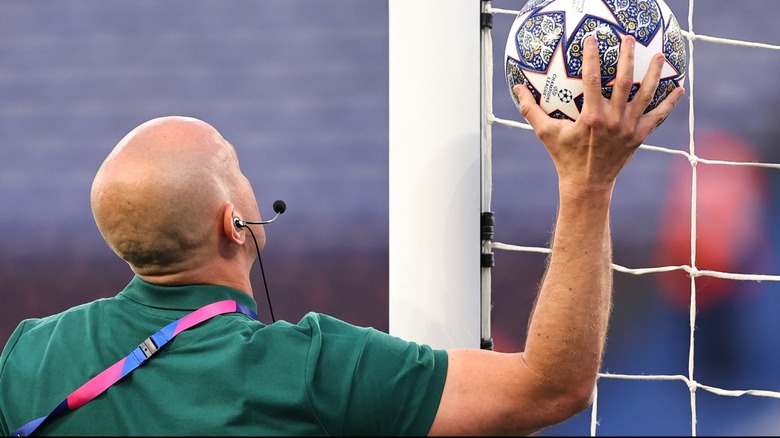Here's How Goal-Line Sports Tech Works In Soccer
In today's high-end sports world, cameras, sensors, and computers work in tandem with referees or other sports officials to ensure fairness. One of the most famous examples of this fascinating sports tech is the goal-line technology (GLT) in soccer. Essentially, it tracks how the ball travels and informs the officials when or if the ball crosses a goal line.
Before FIFA introduced goal-line technology to international football, figuring out whether a ball had crossed the goal line used to be tricky and controversial. Historically, the International Football Association Board (IFAB) has been skeptical of using such technology in football officiating. The Premier League pushed for this technology to IFAB (the only organization that can sanction it) in 2007 without any success. IFAB only yielded and added it to the Laws of the Game five years later, in 2012, after FIFA's nudging and subsequent testing. It's quite late, considering tennis implemented this technology through Hawk-Eye since roughly 2003.
There's no one central system for soccer's goal-line tech. FIFA has a certification procedure to ensure a stadium's system is up to standard. Some stadiums use Hawk-Eye, others may choose GoalControl, and there are others like Cairos Technologies and Adidas' GLT system. Most use a combination of cameras to track the ball, and a few exclusively use sensors in the ball or near the goal post.
What are the most popular GLT systems, and how do they work?
Since there are quite a few goal-line tech systems in soccer, we'll show you how the most popular ones work:
- Hawk-Eye: It was first invented in 1999 by Professor Paul Hawkins as a way to help officiate in games. This monitoring system is the most popular and is used across various sports, including cricket, tennis, and the Olympics. In soccer, It uses six to eight high-speed cameras per goalpost, typically installed on the stadium's roof and sidelines. These cameras read the ball's location in real time with great accuracy. Major European leagues, such as the Premier League, Bundesliga, and Serie A, use Hawk-Eye
- GoalControl: This German-made GLT is based on the same technology as Hawk-Eye. It uses 14 cameras, seven on each goalpost. It's popular for being the goal-line tech system used for the 2014 World Cup in Brazil. However, it built a bad reputation for inaccuracy. Apart from some confusion it caused in the 2014 World Cup, Ligue 1 abandoned it in 2018 due to accuracy issues and opted for Hawk-Eye moving forward.
- GoalRef: This GLT system doesn't use cameras but uses a low-frequency magnetic field on the goalpost's frame. The ball is fitted with a microchip between the surface and the bladder that disturbs the field when it passes the goal line, registering a goal. This system and Hawk-Eye were the two first approved by IFAB.
- Cairos GLT: Cairos Technologies AG and sports giant Adidas collaborated to create their own goal-line tech. It's also based on a magnetic field, similar to GoalRef. Instead of placing sensors on the goal frame, this GLT has a sensor in the ball that triggers when it passes copper wires buried near the goalpost.
Can you trust goal-line technology completely?
The short answer is no, you can't trust GLTs completely. They are designed to be used alongside the referee's and other officials' discretion. The fact that a GLT suggests a goal doesn't mean the referee has to follow it, but it's a strong supplementary argument that there was indeed a goal. All GLTs in standard soccer matches notify the referee via his watch, who then calls the goal or not. In fact, some popular leagues like the MLS still don't have goal-line technology. That is proof that it is a useful technology but not necessary.
FIFA, one of the earliest adopters of GLT, thoroughly tests the system before any match. The tests first start with a goalkeeper test, where the goalkeeper holds the ball outstretched and crosses the line. When the ball crosses the line, they check on the computers to see if it's accurate. Next, the keeper holds the ball close to their chest and crosses the line again. This is to make sure it can detect the ball in partial cover. Finally, they use a slider test, where a machine pushes the ball in millimeters, and they can check when exactly the system detects a goal.


